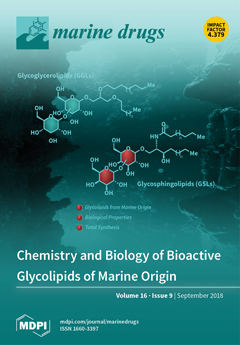1
Department of Applied Chemistry, National Pingtung University, Pingtung 900, Taiwan
2
Division of Cardiology, Department of Internal Medicine, Kaohsiung Armed Forces General Hospital, Kaohsiung 802, Taiwan
3
Department of Marine Biotechnology and Resources, National Sun Yat-sen University, Kaohsiung 804, Taiwan
4
Division of Dentistry, Zuoying Branch of Kaohsiung Armed Forces General Hospital, Kaohsiung 813, Taiwan
5
Division of Neurosurgery, Department of Surgery, Kaohsiung Armed Forces General Hospital, Kaohsiung 802, Taiwan
6
Department of Neurological Surgery, Tri-Service General Hospital, National Defense Medical Center, Taipei 114, Taiwan
7
Center for Environmental Toxin and Emerging-Contaminant Research, Cheng Shiu University, Kaohsiung 833, Taiwan
8
Super Micro Mass Research and Technology Center, Cheng Shiu University, Kaohsiung 833, Taiwan
9
Graduate Institute of Natural Products, College of Medicine, Chang Gung University, Taoyuan 333, Taiwan
10
Chinese Herbal Medicine Research Team, Healthy Aging Research Center, Chang Gung University, Taoyuan 333, Taiwan
11
Research Center for Chinese Herbal Medicine, Research Center for Food and Cosmetic Safety, Graduate Institute of Healthy Industry Technology, College of Human Ecology, Chang Gung University of Science and Technology, Taoyuan 333, Taiwan
12
Department of Anaesthesiology, Chang Gung Memorial Hospital, Taoyuan 333, Taiwan
13
Graduate Institute of Natural Products, Kaohsiung Medical University, Kaohsiung 807, Taiwan
14
Research Center for Natural Products and Drug Development, Kaohsiung Medical University, Kaohsiung 807, Taiwan
15
Department of Medical Research, Kaohsiung Medical University Hospital, Kaohsiung 807, Taiwan
16
Chinese Medicine Research and Development Center, China Medical University Hospital, Taichung 404, Taiwan
17
National Museum of Marine Biology and Aquarium, Pingtung 944, Taiwan
18
Graduate Institute of Marine Biology, National Dong Hwa University, Pingtung 944, Taiwan
†
These authors contributed equally to this work.
add
Show full affiliation list
remove
Hide full affiliation list






